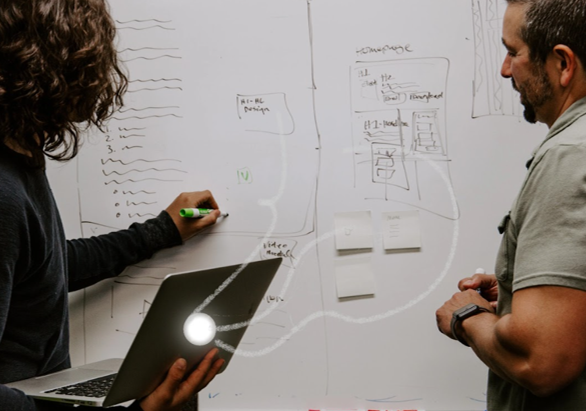The power of viewpoints
Why does our brain sabotage us so often?
Do you know the feeling? You have a great idea that would really advance your family, your team – or your organization. You present it to the group and while your idea is welcomed by enthusiastic supporters, there are just as many skeptical naysayers, not to mention all those perpetually indecisive people. And even if your idea ends up being implemented, it falls victim to precisely those people who are skeptical and indecisive.
Or even worse …
You have an amazing idea or good intentions, and you get going, full of enthusiasm, but just a few hours or days later you notice that you’ve once again fallen into those same old patterns.
Why is that? Why do we find change – even if we see it as something positive – so challenging? And what does this have to do with our brain? To answer this question, we first have to ask ourselves the following question: How does our brain work?

Our brain
Our brain is made up of different parts. For the purposes of simplification, in this context, we’ll just look at the neocortex and the limbic system. The neocortex is primarily responsible for thought processes, whereas the limbic system controls behavioral and emotional responses. The neocortex and the limbic system are constantly communicating to fulfill the brain’s central task. So what is its primary task? The shockingly simple answer is: The survival and preservation of our species. For this, speed, energy efficiency, loss prevention and decisive decisions – among others – are crucial.
Biases
To achieve this goal, our brain, over the course of developmental history, developed the ability to generalize and to thus think, judge and act in patterns and automatisms. The terms used in cognitive and behavioral research are heuristics and biases, which are now being studied in depth. Countless combinations of biases affect our actions day in, day out.
Over 35,000 decisions per day
For the purposes of simplification, we could say that most of the time, our brain is working on autopilot. Most of those – according to current studies – over 35,000 decisions per day (and counting) are made while on autopilot.
This makes sense considering that our brain consumes ten times as much energy in active thought processes compared with the autopilot mode.
In autopilot our brain consumes 2% of the body’s energy. Considering that the brain makes up 3% of the body’s total weight the energy balance is fine. However, not maintainable when actively thinking.
This makes it clear why we find it so challenging to overcome our old patterns in order to make our good intentions and amazing ideas reality. Now we’ve come full circle.
Viewpoints and their effect
What is meant by viewpoints? A viewpoint is the way in which we see things. In addition to representing the perspective from which we view a situation, viewpoints also describe our assessments and opinions as well as the emotions that are linked to it.
And what is the effect of viewpoints? Viewpoints make autopilot mode (see above) possible in the first place. Our viewpoints are driven by implicit assumptions and affect our thoughts and behaviors at the unconscious level. They thus have a direct impact on the results we have achieved.

Viewpoints filter
When we are confronted by other people’s new ideas, these must first pass through our individual viewpoints filter. The latter is justified as it is based on our wealth of experiences and the connected emotions. The same applies to others. They also apply their own viewpoints filter – one that is just as valid – based on their personal experiences and emotions.
This is also the reason why new ideas and changes in our environment often result in uncertainty or even rejection. This, in turn, provides fertile ground for an emotionally charged atmosphere. In the worst-case scenario, this leads to more or less open conflict.
The power of viewpoint-broadening
In summary: Viewpoints are largely responsible for how our lives are shaped. However, they are a double-edged sword. On the one hand, viewpoints help us make quick and decisive decisions in our day-to-day. On the other hand, they have a significant negative impact on our future if they restrict the way in which we shape our future.
When does it make sense to broaden our viewpoints? When we realize that our automatisms and belief systems (autopilot) continuously lead to collisions in our day-to-day – as well as with our living conditions and with other people or their ideas.
How do you effectively broaden viewpoints? First, the good news: The sustainable broadening of viewpoints requires very little effort or time. With the following 5 simple but very effective steps, you will identify and constructively dispel limiting viewpoints.
This is how the exploratory dialog works:
- Explore diverging viewpoints
- Get to the bottom of individual implicit assumptions
- Dissolve limiting assumptions in one-on-one conversations
- Broaden viewpoints together as a team
- Agree on a common modus operandi
The result of the exploratory dialog is a newly acquired self-conviction, based on a sustainably broadened viewpoint.
This process can be practiced by individuals as well as teams and organizations. In teams and organizations, when more than one person is involved, and the broadening viewpoint shall lead to a collective vision these five steps are embedded in an explorative dialog. This way even bigger groups can successfully broaden their viewpoints. Conflicts are avoided or resolved. Nobody resists and nobody loses, because everyone is working towards a shared vision with conviction.
Quantum leap thanks to AI
The extensive experience we have gained through working with viewpoints has taught us the following:
Wisdom of the crowd
The diversity of different viewpoints is immensely valuable and must be safeguarded and salvaged – particularly in the context of an increasingly complex world in which an individual’s know-how is no longer enough but where rather, the collective intelligence is key.
The effects of bias are inevitable
Whenever people with different experiences meet, there is also a latent risk that diverging viewpoints collide, making the effects of biases inevitable.
Deeply rooted
The more deeply a viewpoint is rooted in our subconscious, the greater its impact on our achieved results, and the deeper we have to “dig” to uncover them and to – if appropriate – broaden them.
100% unique
Viewpoints don’t fit into a template. As people, we deserve to be acknowledged, respected and encouraged with all of our unique characteristics. This is why not even the best artificial intelligence can meaningfully replace good, common sense.
Working with viewpoints is highly complex
The complexity of working with viewpoints set natural boundaries and thus initially limited the actual number of people who could be involved.
When Life Institut began its activities over 25 years ago, work with and on viewpoints was still very time-consuming and costly. This is why it was initially reserved for international corporations only.

AI was the logical way to go
Our pursuit of innovation and excellence led us to look for ways to lift these restrictions in order to fully harness the benefits of diverse viewpoints and to also reduce the amount of effort and costs.
Logically, and in conjunction with the opportunities presented by technological developments, this led to the launching of game-changing AI. The constant further development of this AI occurs by integrating findings from the fields of cognitive behavioral science and neuroscience.
Viewpoint-broadening for everyone
A desired side effect of this further development is the fact that currently, entire communities and organizations of all sizes, as well as teams and even individuals enjoy the benefits of broadening viewpoints.
Whether through personal growth, crowd wisdom, mediation, conflict resolution, team development, strategy development, market research, etc., the concrete fields of application are limitless. The only limit is your imagination…
Despite all the benefits of scalability, we feel that broadening viewpoints can never be fully delegated to an AI solution, because the guarantee of success is the smart interaction of human and artificial intelligence, coupled with many years of experience. In this way, we counteract the pervasive effects of bias and together, pave the way to a better future.